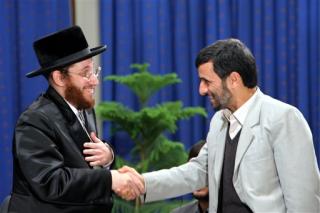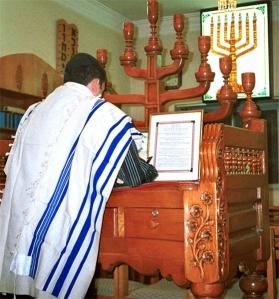 ESFAHAN, Iran – Over the entrance to a synagogue nestled in this ancient city is a banner saying: “Congratulations on the 30th anniversary of the Islamic Revolution from the Jewish community of Esfahan.”
ESFAHAN, Iran – Over the entrance to a synagogue nestled in this ancient city is a banner saying: “Congratulations on the 30th anniversary of the Islamic Revolution from the Jewish community of Esfahan.”
The reality of Iranian civility toward Jews tells us more about Iran – its sophistication and culture – than all the inflammatory rhetoric of its leaders.
That may be because I’m a Jew and have seldom been treated with such consistent warmth as in Iran. Or perhaps I was impressed that all the fury over Gaza, trumpeted on posters and Iranian television, never spilled over into insults or violence toward Jews. (Photo: Rabbi shakes hands with Iranian President Mahmoud Ahmadinejad, www.mehrnews.ir)
The Middle East is an uncomfortable neighborhood for minorities, people whose very existence rebukes warring labels of religious and national identity. Yet perhaps 25,000 Jews live in Iran, the largest such community, along with Turkey’s, in the Muslim Middle East. There are more than a dozen synagogues in Tehran; here in Esfahan a handful cater to about 1,200 Jews, survivors of an almost 3,000-year-old community.
The Jews of Iran meet at dawn — here in Palestine Square opposite a mosque called Al-Aqsa. They remove their shoes, wind leather straps around their arms to attach phylacteries and take their places. Soon the sinuous murmur of Hebrew prayer courses through the cluttered synagogue with its lovely rugs and unhappy plants. Soleiman Sedighpoor, an antique dealer with a store full of treasures, leads the service from a podium under a chandelier.
I’d visited the bright-eyed Sedighpoor, 61, the previous day at his dusty little shop. He’d sold me, with some reluctance, a bracelet of mother-of-pearl adorned with Persian miniatures. “The father buys, the son sells,” he muttered, before inviting me to the service.
Accepting, I inquired how he felt about the chants of “Death to Israel” – “Marg Bar Esraeel” – that punctuate life in Iran.
“Let them say ‘Death to Israel,” he said. “I’ve been in this store 43 years and never had a problem. I’ve visited my relatives in Israel, but when I see something like the attack on Gaza, I demonstrate, too, as an Iranian.”
 Over the decades since Israel’s creation in 1948 and the Islamic Revolution of 1979, the number of Iranian Jews has dwindled from about 100,000. But the exodus has been far less complete than from Arab countries, where some 800,000 Jews resided when modern Israel came into being.
Over the decades since Israel’s creation in 1948 and the Islamic Revolution of 1979, the number of Iranian Jews has dwindled from about 100,000. But the exodus has been far less complete than from Arab countries, where some 800,000 Jews resided when modern Israel came into being.
In Algeria, Tunisia, Libya, Egypt and Iraq – countries where more than 485,000 Jews lived before 1948 – less than 2,000 remain. The Arab Jew has perished. The Persian Jew has fared better.
Of course, Israel’s unfinished cycle of wars has been with Arabs, not Persians, a fact that explains some of the discrepancy. (Photo: Iranian-Jew Praying in Synagogue in Iran, by US State Department)
Still, a mystery hovers over Iran’s Jews. It’s important to decide what’s more significant: the annihilationist anti-Israel ranting, the Holocaust denial and other Iranian provocations—or the fact of a Jewish community living, working and worshiping in relative tranquillity.
I know, if many Jews left Iran, it was for a reason. Hostility exists. The trumped-up charges of spying for Israel against a group of Shiraz Jews in 1999 showed the regime at its worst. Jews elect one representative to Parliament, but can vote for a Muslim if they prefer. A Muslim, however, cannot vote for a Jew.
Among minorities, the treatment of the Baha’i seven – of whom were arrested recently on charges of spying for Israel – is brutally harsh.
I asked Morris Motamed, once the Jewish member of the Majlis, if he felt he was used, an Iranian quisling. “I don’t,” he replied. “In fact I feel deep tolerance here toward Jews.” He said “Death to Israel” chants bother him, but went on to criticise the “double standards” that allow Israel, Pakistan and India to have a nuclear bomb, but not Iran.
Double standards don’t work any more; the Middle East has become too sophisticated. One way to look at Iran’s scurrilous anti-Israel tirades is as a provocation to focus people on Israel’s bomb, its 41-year occupation of the West Bank, its Hamas denial, its repetitive use of overwhelming force. Iranian language can be vile, but any Middle East peace – and engagement with Tehran – will have to take account of these points.
Green Zone-ism – the basing of Middle Eastern policy on the construction of imaginary worlds – has led nowhere.
Realism about Iran should take account of Esfahan’s ecumenical Palestine Square. At the synagogue, Benhur Shemian, 22, told me Gaza showed that Israel’s government was “criminal,” but still he hoped for peace. At the Al-Aqsa mosque, Morteza Foroughi, 72, pointed to the synagogue and said: “They have their prophet, we have ours. And that’s fine.”
Roger Cohen is a columnist for the New York Times and the International Herald Tribune.
This article, originally published 22 February 2009, is distributed by the Common Ground News Service (CGNews) with permission from the International Herald Tribune. Reprinted with permission.



















